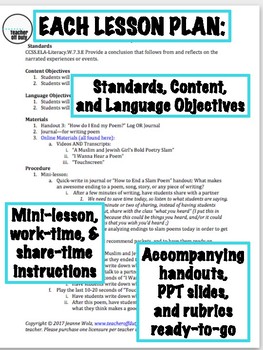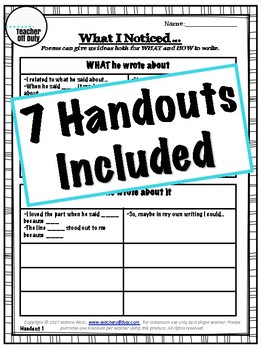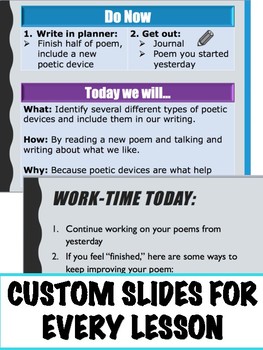Slam Poetry Mini Unit
- Zip
What educators are saying
Description
Looking to add slam poetry to your poetry unit, but too swamped to plan it out? I’ve got you covered. This one-week slam poetry mini-unit is designed to be inserted into your poetry unit, and is packed with 5 days of my best slam poetry lesson plans. It will take your students through brainstorming, drafting, performance-planning, and performing all in a week. It’s the perfect unit to give your students a taste of slam poetry (and get them begging for more). You’re students will never think about poetry in the same way again.
This unit is a part of a bundle/larger unit plan, called Slam Poetry Unit Plan, Identity and Assumptions
This unit consists of 61 pages for a one-week slam poetry mini-unit, with the following break-down:
-13 pages of detailed lesson plans
-37-Slide Powerpoint
-11 pages of handouts, including editable versions, for scaffolding and integrated assessment (22 pages including both editable and uneditable versions)
-Link to specially curated slam poetry videos, along with places online to find transcripts
The 5 lesson plans in this unit include:
1. Day 1: How to Brainstorm and Begin a Slam Poem (Slam Poetry Day One Lesson)*
2. Day 2: Writing to Include Poetic Devices**
3. Day 3: How to end your poem**
4. Day 4: What makes a powerful slam poetry performance**
5. Day 5: Gallery Walk Performances (Speech Gallery Walk Lesson)
*As featured on my blog, www.teacheroffduty.com, but with exclusive additional resources not included in blogpost
**Included in Slam Poetry Unit Plan, Identity and Assumptions
Each lesson plan includes:
-CCSS Standards
-Content Objectives
-Language Objectives--especially useful for your Emergent Multilinguals (ELLs), but benefits all students
-Mini-lesson--plan and slides
-Work-time--plan and slides
-Share-time--plan and slides
-Ideas for formative assessment
Looking for some more slam poetry than for just a week? I don’t blame you.
You may prefer my 3-week Slam Poetry Unit Plan instead, found here.
You may also be interested in these other units:
If you purchase this product, I'd love to hear how it went! Please respect the Terms of Use by leaving an honest review of this product so that I might help more teachers and students like you and yours!





